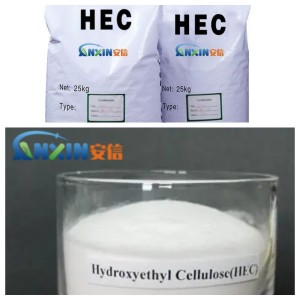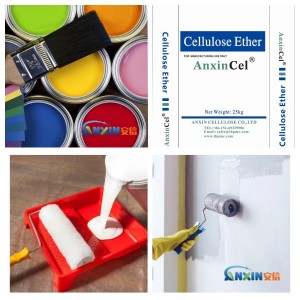Hydroxyethyl cellulose (HEC) is a nonionic, water-soluble polymer derived from chemically modified natural cellulose. It exhibits excellent thickening, film-forming, emulsifying, stabilizing, and water-retention properties. In waterborne coating systems, HEC is one of the most commonly used thickeners and rheology modifiers. Its combined performance directly impacts the coating’s workability, storage stability, and film-forming properties.
1. The Main Roles of HEC in Waterborne Coatings
1.1. Thickening and Rheology Modification
HEC has excellent water solubility and thickening properties. It increases system viscosity through physical entanglement and hydrogen bonding, effectively improving the coating’s rheological properties. This results in a higher viscosity at rest, preventing pigment settling. During application, it exhibits excellent shear-thinning properties, ensuring a balanced leveling and brush/roller coating performance. This “pseudoplastic” rheological property is crucial for smooth coating application and uniform film formation.
1.2. Stabilizing Dispersion Systems
The abundant hydroxyethyl groups on the HEC molecular chain can form hydrogen bonds or electrostatic interactions with the surfaces of pigments and fillers in water-based paints, thereby enhancing the stability of the dispersion. This prevents pigment flocculation and sedimentation, improving the storage stability of the paint and extending the shelf life of the product.
1.3. Improving Application Performance
Adding an appropriate amount of HEC enhances the thixotropy of the paint, reducing splashing and sagging during application. Especially in facade or ceiling applications, HEC’s thickening effect effectively prevents sagging and ensures a more uniform film thickness. It also improves lubricity during brush and roller application, resulting in a smoother application feel.
1.4. Film Formation and Water Retention
HEC’s high water retention helps control the drying rate of the coating, preventing defects such as cracking and pinholes caused by rapid evaporation. In certain systems, it also helps form a uniform and dense film structure, improving adhesion and surface gloss.
1.5. Strong Compatibility and Environmental Adaptability
HEC is a nonionic thickener with excellent compatibility with various anionic, cationic, and nonionic emulsions. It can be widely used in various systems, including acrylic emulsions, vinyl acetate-acrylic emulsions, and ethylene-vinyl acetate copolymer emulsions, adapting to different application environments and formulation requirements.
2. Applications of HEC in Various Water-Based Coatings
2.1. Interior and Exterior Latex Paints
HEC is a commonly used thickener in latex paints, significantly improving paint stability and application performance. For interior paints, it enhances film smoothness and spatter resistance; for exterior paints, it helps improve weather resistance and scrub resistance.
2.2. Water-Based Wood Coatings
In wood coating systems, HEC provides excellent leveling and clarity, controls sagging, and ensures a smooth, uniform film. Furthermore, its low odor and environmentally friendly properties align with the development trend of modern green coatings.
2.3. Industrial Waterborne Coatings
HEC can be used in industrial systems such as waterborne anti-rust paints, floor paints, and metal protective coatings, improving their storage stability and application adaptability, offering the advantages of both cost control and stable performance.
2.4. Artistic and Special Effect Coatings
Due to its controllable rheology and good system compatibility, HEC can be used in special effect coatings such as sand-textured paints, stone-like paints, and textured paints, helping to achieve specific decorative textures and surface textures.
3. Application Prospects of HEC in Waterborne Coatings
With stricter environmental regulations and the gradual phase-out of solvent-based coatings, the market share of waterborne coatings continues to expand. As a naturally derived, low-toxic, and environmentally friendly thickener, HEC aligns with the industry trend towards greener, lower-VOC technologies. Future development directions for HEC will focus on the following areas:
High-Performance Modification: Improving shear resistance, enzymatic resistance, and temperature stability through structural manipulation to meet the needs of high-end coating systems.
Intelligent Rheology Control: Developing HEC derivatives with shear-responsive and temperature-sensitive properties enables more precise adjustment of application performance.
Compounding Applications: Compounding with polyurethane, acrylic rheology modifiers, or cellulose ethers creates a composite thickening system, enhancing overall performance and cost-effectiveness.
HEC is not only a traditional thickener in waterborne coatings but also a key functional additive that achieves a balance between workability and environmental performance. With technological advancements and growing demand for green building materials, its market application prospects are expected to expand.
Post time: Oct-14-2025

